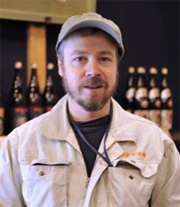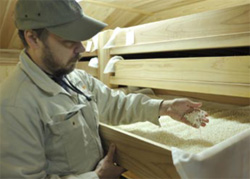Home > Highlighting JAPAN > Highlighting Japan JANUARY 2012 > Toji Philip Harper
Highlighting JAPAN
MASTERS
Toji Philip Harper
Like Japanese food, Japanese rice wine, or sake, is growing in popularity around the world. One person for whom sake is more than just a pleasant drink however is Philip Harper, the first and only non-Japanese ever to acquire the title of toji, or master brewer. Toshio Matsubara profiles the award-winning brewer.

Philip Harper in the Kinoshita Brewery shop at Kyotango, Kyoto Prefecture
Credit: YOSHIFUSA HASHIZUME
It is the toji who manages the sake brewery workers known as kurabito, and takes full responsibility for every aspect of the brewing. In the past, toji were farm workers who would brew sake to make a living during the agricultural off-season. Requests would be received from brewing company owners, and with kurabito (the majority of whom were farm workers themselves) in tow, the toji would live at the brewery from autumn to spring, during which time they would fully immerse themselves in the brewing of sake. The work was done on the basis of annual freelance contracts, and it was common for toji to switch between multiple sake breweries depending on their compatibility with an owner, the terms offered and so on. As the flavor of sake requested by an owner and the equipment available differed depending on the brewery, toji would hone a unique set of skills through a process of trial and error at each new brewery.
The early 1990s, when Harper started learning the craft of sake brewing as a kurabito, was the end of the era of the traditional toji system. Thereafter, sake brewing was also swept up in the wave of "rationalization," and the family of brewery owners or its directors came to assume the role of toji. While these measures were adopted to provide stability for companies' organizational structures, it also came with a downside. Since these breweries only knew about their own techniques, they came to hold a narrower view of sake brewing. Although Harper was among the last generation to train under the tutelage of old toji, "that [heritage] is my most valuable asset," he says.
For Harper, who passed a screening test to qualify as a toji in 2001, Kinoshita Brewery was the second brewery he had worked at as toji. The first thing Harper set out to do at Kinoshita Brewery was to utilize a traditional sake brewing technique he calls shizen-shikomi, or "natural preparation."
Since the Meiji period (1868–1912), sake has been brewed by adding lactic acid that inhibits the propagation of bacteria during the shikomi process, and by then adding pure yeast cultures. This is because doing so eliminates inconsistencies in quality and enhances the efficiency of the fermentation process. In the traditional method called kimoto, lactic acid is not added, but almost all contemporary brewers in that style do add pure yeast cultures. Harper's shizen-shikomi is the extremely rare pre-modern method where only rice, koji mold and water are used as the raw ingredients and no lactic acid or cultured yeast whatsoever is added. While the fermentation process is left to natural yeast which has been established for hundreds of years at the brewery, control of the process requires meticulous care.

Philip Harper checks the koji mold at Kinoshita Brewery.
Credit: YOSHIFUSA HASHIZUME
Sake made by Harper in his first year at Kinoshita Brewery went on to win gold in the National New Sake Awards, catapulting the sake into the limelight. Its magnificently pure flavor earned it the highest of praise.
Before Harper came, almost 100% of Kinoshita-Shuzou's product was being shipped to nearby areas, but over the last five years production has more than doubled and the brewery has undergone rapid growth with shipments of sake not only throughout Japan but also to export markets such as the United States, England and Hong Kong.
"While the quality of the grapes is said to determine 80% of the finish of a wine, for sake, the quality of the rice used only determines the outcome by 20% at most. Truly complex processes are required, and microbes must transform the rice into something completely different [rice koji] before fermentation can even begin. To that end, 'calm' is an essential quality for staff, and in no way am I speaking in an abstract sense. Without fail, the sake produced by a brewery with strained interpersonal relations will taste bad."
Sake brewing is infinitely close to agriculture, says Harper. Things don't work at the pace set by humans. The brewers work as a team to tailor their efforts to the workings of nature, employing the best possible methods while giving meticulous thought to the state of the microbes at all times. Harper says he learned what the most important aspects of sake brewing were through the traditional toji system. During the seven-month period from the start of sake brewing in October through to April, Harper doesn't take a single day off. Even during the off-season, Harper is tireless as he holds lectures in Japan and overseas to communicate the appeal of sake.
"I've had several invitations from overseas to go and work as a chief sake brewer, but in the end I want to produce sake here in Japan where the tradition is. It might be physically and mentally draining, but it is a truly rewarding job."
© 2009 Cabinet Office, Government of Japan






